![]()
![]()
![]()
![]()
![]()
![]()
![]()
![]()
A note from
Bill Ladabouche: This informal history page is simply an attempt - from my
memory - to give the uninitiated reader a general idea of how Catamount
Stadium's lifespan transpired. If you are certain of inaccuracies, please
contact me and let me know. This particular piece was not done with very much
help from anyone else.
Contact me at: wladabou@comcast.net
FEATURES AT BOTTOM OF T HE PAGE
The
Background: The Pre-History for Catamount
CLICK
HERE to go to the page for Pre-Catamount History
[for many older tracks] This has not been updated in a long time.
Racing in Vermont had been going strong since the days of Fair Haven's Fairmont Speedway, the fairgrounds in Sheldon, Bennington's Stateline Speedway, Rutland's Pico Raceway, and even nearby Granville, NY's Mettowee Speedway. In Northern Vermont, various race tracks have operated in South Burlington, Malletts Bay, Enosburg Falls, Lower Waterford's Northeast Speedway, and Vergennes' Otter Creek Speedway - to name a few. In fact, in just one year in the early 1950's, Vermont had 22 tracks going at once.
Some of these participants - or sons, daughters, and grandchildren of these participants have gone on to compete, work as mechanics, pit crew, or even write - all in an effort to be in the Vermont racing scene. It is these people who laid the groundwork and made Catamount Stadium what it was.
State Championships were established at practically every track, Except for NASCAR, there was no way of authenticating whether someone was a tgrue state champ or not. Amidst this chaos, a few men stood out among the early Vermont stock car racing fraternity as those who had a big effect on the state's racing and, therefore, on Catamount - when it began.
In 1960, a new track was constructed and open in Barre, Vermont - Thunder Road International Speedbowl. Owned by race announcer, Ken Squier, a local radio station owner, and Reginald "Spade" Cooley, a Barre - based paving contractor, the track more resembled today's modern track complex than it did the relatively - crude little ovals that had sprung up all over the state. The track was paved, first of all, and featured a go-cart road course which wound through the infield. The seating and the pit location were also fairly unique to the era.
Somewhat before T - Road, NASCAR had been operating in a speedway, in Malletts Bay. The Barcomb family operated the track, much to the resentment of the neighboring drive - in theater. Several people who would be instrumental to Catamount's success began at Malletts Bay. Most notable of these was a young Milton man named Harmon Dragon [sometimes mistakenly identified as Herman Dragon].
Malletts Bay hosted racing teams from all over northern Vermont and parts of New York. It also supplied competitors for the short - lived Otter Creek Speedway, a NASCAR affiliate in the town of Waltham, near Vergennes. Dragon, Red Dooley, Wayne Chandler, Aimer 'Sonny" Gover,and flagger Bucky Barlow were a few of these names. Otter Creek Speedway saw some amazing names on its lineup cards before it faded away in the late '60's.
Click on the track logo to go the Thunder Road page.
Things were going very smoothly at Thunder Road by the mid - '60's. The huge fields included a healthy contingent of New Hampshire drivers, many of whom had come from the Elms Family - operated Northeastern Speedway in Waterford: the wild Ingerson brothers, Roy "Pappy"Forsythe, Ronnie Marvin, Stanley "Stub" Fadden, Hank Montandon, and more crossed the Eastern border to run against Vermonters like Chester T. Wood, John Gammell, Tony Colucchio, Larry Granger, etc.
The Beginning
Thunder Road was such a success, and Nascar racing was progressing so well, that some of the more forward - thinking movers and shakers in northern Vermont racing began thinking bigger. They realized that a well - located track, in a well - populated area and near major transportation arteries, would serve not only to heighten racing awareness in the area, but it could centralize racing between Thunder Road and the more westerly Airborne.
After some research, a spot was identified, near Interstate 89 and Route 2, still the best route into New York State. Located in the far - flung Chittenden County town of Milton, this plot of land would be accessible to the Montreal market, as well as potential new interests in Burlington, Vermont's largest city. With the establishment of a track at that location, the circuit would not have to depend on Airborne to draw in New York - based NASCAR teams.

From TerraServerUsa Web Site
As seen in this TerraServer Usa map, the track was located right off US Route 7 [shown in brown on the right] and Interstate 89 [shown by double purple lines at left]. The lot was a large, flat area. on which they would build a new access road [that runs perpendicular from Rte. 7 nearly to Int.89]. Residential housing was sparse in the area, in 1965, with the only significant development to come a few later on Mayo Road [shown to the left of the number 206]. According to the Catamount History, which came out in 1985, the land was bought from a local farmer named Kermit Bushey. So, how it ended up in the hands of the Greater Burlington Industrial Corporation begs investigation.
The group of six men who came up with the idea on rather short notice late in 1964 were : Ken Squier, Thunder Road track announcer and a local radio station owner; the Cooley brothers - Ray and Reginald, paving contractors; Burlington businessman and race driver Jack DuBrul; car owner Gordon Fitzgerald; and Milton contractor John Campbell. Once begun, the track came together fairly quickly, given the fact that very few services had to contracted out to firms other than those run by the owners.

History of Catamount Program Photo A car drives around the freshly - graded third and fourth turns at the soon - to - be Catamount Stadium 1/3 mile racetrack.
|

History of Catamount Program Photo The track awaits final paving, next to the completed retaining wall, fencing and announcer's stand at Catamount . Jack DuBrul would soon bring in the grandstands, some of which lasted until the track closed over 20 years later.
|
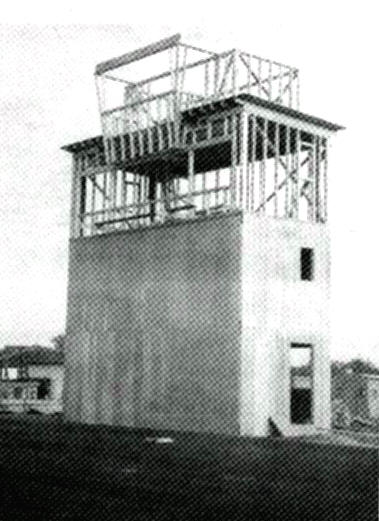
History of Catamount Program Photo Construction of the announcer's stand, and food service buildings proceeds at a rapid pace in early Spring, 1965.
|
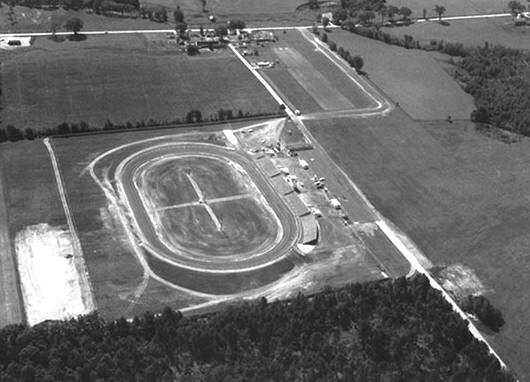
ACT Office Archives Photo This is an aerial shot of Catamount's layout just a
few weeks before opening day. |

The famous Catamount sign that stood out, at the entrance to the access road. In the right photo, it is being refurbished at the author's house in 1979.
The track had certain historic milestones in its somewhat brief lifetime. What seemed like the hardest part was accomplished fairly quickly and easily. Now, it seemed like the easy part would be opening the gates and letting the anxious competitors inside. It didn't work out that way. In the inaugural 1965 season, fields were very small. Oftentimes, the track could not field three qualifying heats in the modified/sportsman class...... and the support division, the Flying Tigers, was just being developed. True, Thunder Road had a support class that was similar, but few of these competitors wanted to travel as far as Milton. The new Tigers would be low-buck late models who were allowed to have one racing slick - on the outside front.

This photo from the Catamount history program of 1985 shows how small coupes fields were. This wasn't a heat - it was the FEATURE !
Some key dates in Catamount Stadium history:
I welcome input on any information, as I have only my memory to depend upon. Some of these dates may not be right.
the actual opening of Catamount Stadium in 1965
the Beaver Dragon upset win, in the Catamount modified/sportsman class - 1967
the departure of the coupes and modifieds - 1968
the development of the multi-track circuit system - 1973
the beginning of the "Beer Tours" - 1975
the big split - ACT moves in and NASCAR moves out, with many of the competitors - 1986
ACT tries running with the big dogs - 1987
the final year - 1987

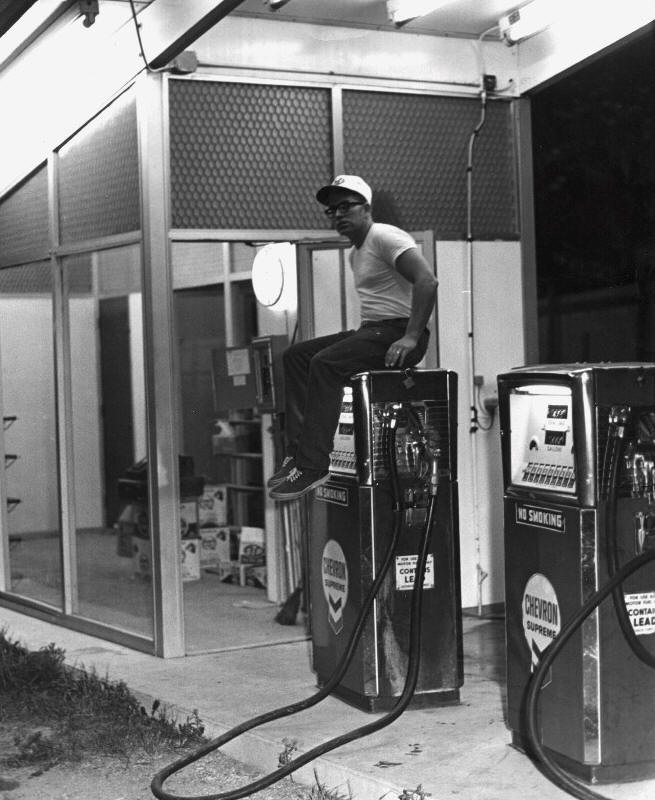
ACT Office Archives Photo
The Catamount pace car from around 1967 [left] and the old pit area gas station that dispensed Chevron Supreme gasoline for years. The building was later replaced by the handicapper's stand, which very probably came from the old Milton Speedway dragstrip. Too many guys got on the roof to watch a race, and it collapsed.
One of the most dramatic of these was the shocking victory of hometown hero Harmon "Beaver" Dragon, in the Vermont State Championship, in 1967. Dragon, who had already been running at Malletts Bay, Northeastern, Thunder Road, and Otter Creek, started out in the Catamount support division, The Flying Tigers. After two years, he, John Bourgeois, and Ernie Preiss had outfitted a pretty competitive little 1937 Chevy into a sportsman. Dragon shocked the far - more - famous coupe competitors when he won the Vermont State Championship in that same year.
Photo courtesy and John and Marge Bourgeois.
This photo shows the moment all of the Milton fans were waiting for. Beaver Dragon had taken a sportsman feature - and a big one, at that. From left - crewman Ernie Preiss, Beaver, and owner Johnny Bourgeois [who became much more famous as Catamount's track maintenance man and the man who developed the speedy - dry spreader].
One of the most controversial and infamous periods in the history of the track was when the tremendously - popular hometown Dragon brothers became embroiled in a dispute with the track management and pulled out for a period of time. Both ended up competing at Devil's Bowl, a small clay oval to the south, near Fair Haven, Vermont. In their absence, Catamount moved from limited sportsman cars to the full late model sportsman. By the time both brothers had returned to the fold, their familiar rivals had been joined by an ever-growing cadre of new homegrown talent and out- -of - state invaders.
Bill Ladabouche Collection Photo
A less than happy-looking Bobby Dragon poses with his modified after he had moved his act to Devil's Bowl in 1971 during his self - imposed exile from Catamount.
The track and its sister tracks were soon ready for the big-time; and that came in the form of a five - track circuit in 1973. The Northern NASCAR Circuit ran at Catamount, Devil's Bowl, Thunder Road, Sanair, and Airborne. It was a grueling schedule which almost wore out the competitors. But. amazingly, many of the drivers and teams ran the full gamut and emerged with inflated NASCAR points totals which propelled them into unfamiliar, high places in the NASCAR National Late Model Sportsman points standings that year.
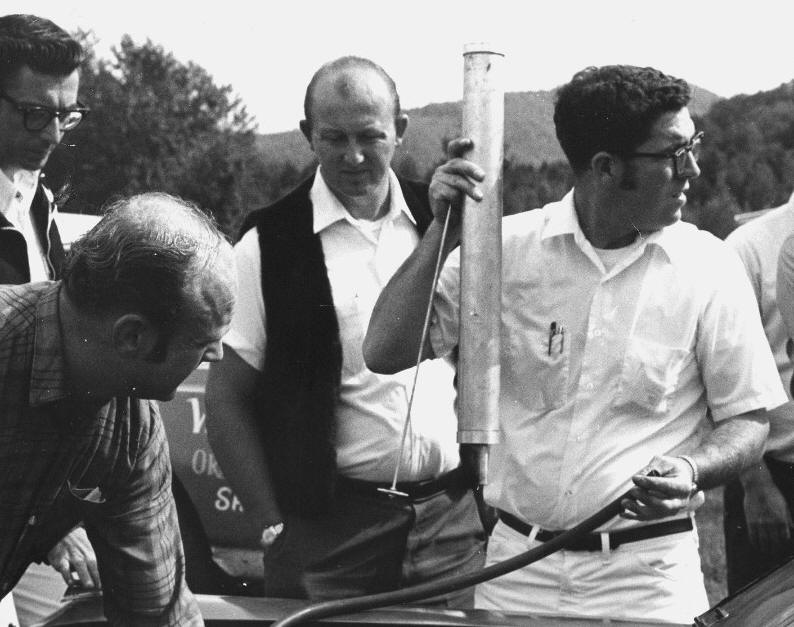
From the ACT Office Archives
A Catamount technical inspector named Bushey checks the cubic inches on a feature winning car, as Roger Paquette [center] another official, looks on.
After the crucible of 1973, the Northern NASCAR Circuit ran a considerably more realistic schedule. Catamount ran races, in conjunction with Thunder Road and sometimes Airborne for the next few years. The circuit's late model sportsman teams refined their acts and honed their skills during these relatively calm and serene years.

From the ACT Office Archives
Catamount technical inspector Pat McGrath, a former Malletts Bay driver, stands by the flaggers' area at Catamount. [Right] Pat, as a driver at Malletts Bay.
This ushered in the era of the beer tours. Molson, Stroh's and Coors all took turns sponsoring the late models. At this time, officials decided it was not in the best interest to run regular weekly at Catamount - that the best approach was to have big - paying, periodic large events at the track, while having the division tour around as guest stars at widespread venues from deep into Quebec to points in southern New England.

From the ACT Office Archives
Randy Corey, a former handicapper's assistant driving for Bob Curtiss, became one of the stars of the Friday night series.
Early in this period, Catamount tried eliminating weekly shows. It became evident that many of the fans could not or would not tour all around, chasing the late models to points all over the map. Some of regular shows had to return. At this time, there were the late models, Grand Americans, and Street Stocks. Possibly the lower two divisions could sustain weekly programs. Eventually, in the early 1980's, it became obvious that the regular shows needed more, so Tom Curley came up with the idea of weekly Friday night programs for late models. Essentially, the program would be for the lower budget teams and the younger drivers in need of experience.
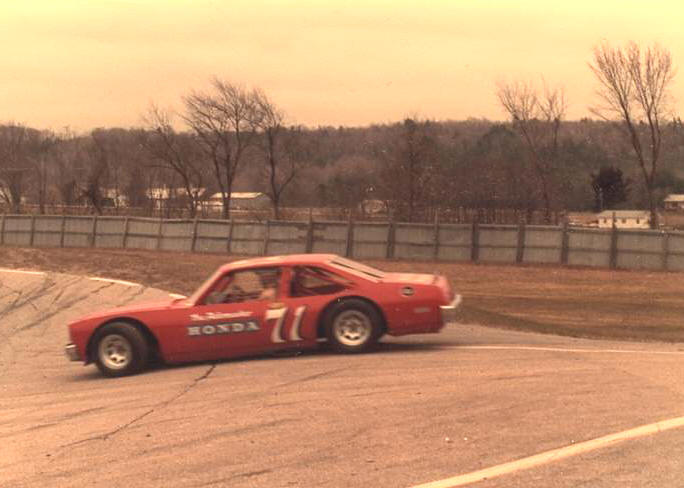
Courtesy of Darrel Rogers
Bob Dragon, a consistent star in the late models until the big split in 1986, goes out onto the Catamount oval for practice laps.
During the time that Catamount was trying to make regular weekly shows work, it occurred to management that one of the biggest successes in the track's history was the original Flying Tigers. They decided to try to return to a Tiger division around 1982 or 1983. The division would be created from a contributing base consisting of Grand American, Street Stock, and even Mini Stock teams. Into this mix, Curley hoped to infuse new stars. After a relatively unimpressive start on Thursday nights at T-Road, the new Flying Tigers began to catch on. That first year, the fields were a curious mixture, to say the least. Former Grand American Mustangs and Camaros would line up along side an occasional upgraded Street Stock car and some very strange rigs brought in from other tracks.
Eventually, the class was honed down to a fairly uniform type of car, the stranger and more unsuitable teams were weeded out, and the Tiger began to attract their own fan base. This division was one of the ones in effect when the sands of Catamount's hourglass began to run out. Sometime the 1987 season, it is said that track management approached the Greater Burlington Industrial Corporation about a lease extension and were turned down cold.

Courtesy of Steve Pecor
They just couldn't wait to tear her up. What did they think, we were coming to reclaim it or something ? [Great idea, actually]
The last program at the track was an enduro that had been scheduled for quite some time. It struck many of us that this was a most inappropriate final program for such a magnificent short track as was Catamount Stadium . GBIC wasted little time after that enduro, tearing the track surface up withhin aboout a week. The local fire department was offered the tower and the Milton Hilton for hose practice, a task they sadly performed lest some strangers destroyed it. I don't know where the stands went.
Today, there is precious little left to see of the facility. A road runs through the track, entering closer to turns one and two than to three and four [although it seems the opposite when you are there.] There is some pavement left from the area behind the bleachers where the concession stands sat, and there is a part of the pit ramp off turn one still fighting to stay above the weeds. The concrete block used to unload cars is till there, but the water well building, that stood with it for so long is pretty much totally collapsed within the last year [2014].
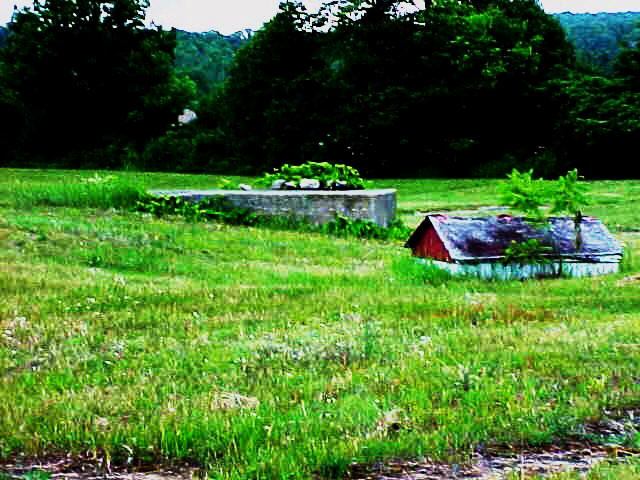
Bill Ladabouche Collection Photo
The loading block is hanging in there - but the well house is sinking fast now, as of 2015.
A most sad ending.
CATAMOUNT VIEWS
Click HERE to Go to the Catamount Views Page

This partial satellite photo from 1999 shows how the contour of the track still is visible in the Catamount Industrial Park.
CATAMOUNT BITS IN TIME
Big and Small Anecdotes about What Was Catamount
Click on the checkered flag to go to the Catamount Bits Page
DISTINGUISHED CATAMOUNT GRADS
Catamount Participants Who Have Gone on to Prominent Roles Elsewhere
Click on the checkered flag to go to the Catamount Grads Page
DUPLICATE RACING NAMES
Catamount Participants Who Have The Same Name as Another Prominent Person
Click on the checkered flag to go to the Duplicate Names Page
DRIVERS WHO TRIED THE BIG TIME
Regional Saturday Night Participants Who Tried One of NASCAR's Upper Level Divisions
Click on the checkered flag to go to the Big Timers' Page